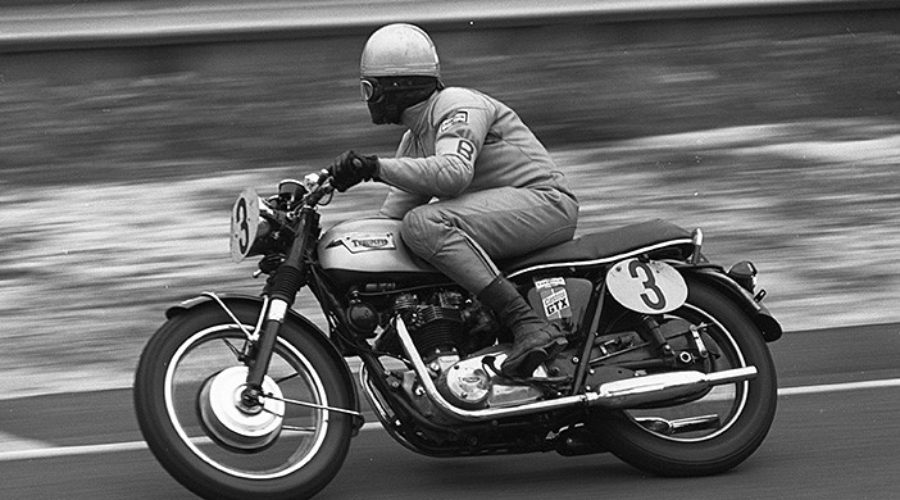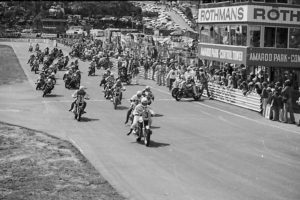The 1970 Castrol Six Hour Race
It’s 50 years since the first Castrol Six Hour. Two Wheels was there. Here’s the magazine’s original race report, titled “Street Bikes Pour on the Action.” And they certainly did!
When we at Two Wheels first heard of the scheme to hold a six-hour production bike race, we wondered how closely its early development would parallel that of the comparable event for four wheelers, the Bathurst 500, known variously as the Armstrong, Gallaher and Hardie-Ferodo, and even Philips Island 500, if you want to go back far enough.
Now that the event has been held for the first time, we are still wondering. Remember the 1969 Bathurst 500, when a large slice of the field was eliminated in a first-lap pile-up?
Well, in that much, at least the first Castrol 1000 Six-Hour Production race, was similar. The first lap saw some 19 bikes involved in a tangle, and a couple more came to grief in the ensuing confusion with the ambulance on the track.

However, with that one exception, the race was a first class piece of motorcycle racing action, and a credit to the organisers, the Willoughby District Motorcycle Club.
The Bathurst 500’s early chopping and changing of sponsorship seems likely to be avoided in the case of its two-wheeled equivalent, since all reports and general feeling so far seem to indicate that Castrol was more than happy with the outcome, and could confidently be expected to back the race again next year.
And it will definitely be on again next year. Planning is already underway, and will include several improvements to lessen the chances of such mishaps and confusion as occurred this time.
The $1000 first-place-outright purse provided by Castrol could probably take much of the credit for the large entry list.
And at that same large entry list could be directed a lot of the blame for the mishaps and confusion – too many bikes on the tight Amaroo Park circuit at one time.
Once the field had strung out after the first few laps, the incidents became fewer and farther between, and the action settled down into good fast racing.
But then again, that same stringing-out caused some little confusion as far as lap scoring was concerned. Machine X was called as being ahead of Machine Y, when in fact X had a two-lap disadvantage after a pit-stop, and so on.
By the official lap charts, however, everything had been faithfully recorded. All machines were accounted for on every lap, with length and number of pit stops clearly defined, so that the worst criticism one can direct at the lap scoring is that it was perhaps a bit slow.
By now, of course, the results are well known, but perhaps some of the sidelights might not be.

F’rinstance, take a look at the right-hand footpeg on Craig Brown’s 750 Honda, and then try and tell us he wasn’t trying hard!
Or the right-hand rocker-box of the BMW R75/5 … worn very nearly right through after just two hours of racing!
On the subject of trying hard, it may just be possible that in many cases, the accidents were brought about by guys trying just a bit too hard, and pressing on beyond their own limits.
In fact, in at least a couple of cases, we know this to be so – things like ignoring flag marshal’s signals just don’t happen unless somebody is out to win at any price!
You can scoff if you like, but in at least one case that’s exactly what happened. No names, no pack drill, as they would say in the Army, but it was a bloke who certainly should have known better.

Another factor, and one that may seem a bit absurd at first glance, is well worth thinking about.
There are a lot of star riders who never swing a leg over a road machine. They travel by car, towing racing machines with rearset footpegs and dropped handlebars, so that most of their riding is done with the nose on the tank and the knees under the armpits.
Faced with a machine that offers a more normal road-style seating position, they find themselves just sufficiently at sea to slow them down and give the edge to guys that ride on the roads every day.
Yeah, like I said, it sounds absurd, but think about it. Apparently, from what we hear from a couple of the aces, it’s a critical factor.
And when you realise that some of the star names, who should have done better on the basis of their past racing records, just weren’t in it, it tends to lend weight to the theory.

Among the outstanding rides of the race must be that by Bill Horsman and Ian Ardill, from SA, on a 350 cc R5 Yamaha in the under-500 cc class.
Well up with the leaders in the early stages, the machine got a bit lost in the confusion as the race unfolded, and it must have been quite a surprise to a lot of people to find, when the results were finalised, that the bike had come in fourth outright.
Another top notch ride was that turned on by the ladies’ team of Sandra Davis, Janet Middleton and Linda McFarlane on another R5.
To the girls’ credit, each of them chipped in large lumps of lolly to buy the machine and prepare it for the race, and then managed to bring it home over the full distance ahead of quite a number of men’s teams.
But the award for startling result of the day must go to Dave Burgess of the Pittwater Motorcycles Suzuki 250, coming in third outright and first in the lightweight class … third outright over bigger and theoretically quicker machines.
Due credit, too, to John Steain, bringing his well-and-truly superceded Suzuki 250 into third in the lightweight class ahead of newer chargers.

It would be easy to spend another three or four pages recording the feats of various teams, but it will have to suffice to say that, with the exception of the guys who came to grief through no fault but their own, the race was a fine display by all concerned.
And it should be even more exciting next year, provided it doesn’t go the way of the Bathurst 500 – you know what I mean; supposedly standard machines that are about as close to standard as Sydney is to Perth!
Tickled suspension, ring-in gearing, subtle and sneaky engine mods, and all the rest of the tricks that could just slip by the scrutineers.
Don’t laugh! Ask anyone who knows – very few cars in the Bathurst 500 are strictly standard. Let’s not allow the same thing to happen to the Castrol 1000. It’s a great idea. Don’t let it become a huge joke!
The Castrol 1000 was a breakthrough in local motorcycle racing, with big prizemoney for a long-distance production race. With this experience as a guide, the Willoughby Club predicts that the 1971 event will offer even more for the enthusiast, both on the circuit and behind the fences.
By Marti Dunstan. Pix David Campbell and Michael Andrews. Two Wheels, January 1971.

In 1984 the ABC made a fabulous documentary, Six Hours in History. Watch it here.


